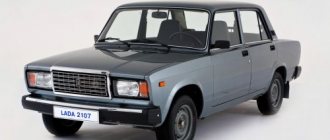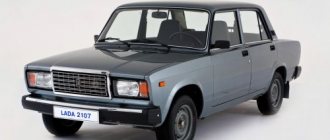Options for solving the problem of Lada Priora with increased idle consumption
You should not base your car’s fuel consumption on the basis of the indicators provided by the on-board computer. As is known, such technologies, especially considering that they were produced in Russia, have low accuracy. To check the actual consumption, you need to use the often practiced “from refueling to refueling” method:
- first, the fuel tank is completely filled;
- the flow meter counter is set to zero;
- driving is carried out until a signal lights up on the dashboard, indicating that the fuel level is close to zero;
- then the car is refueled again to a full tank.
As a result, you need to look at the refueling machine's meter to see how much gasoline was actually filled, then compare this data with what is displayed on the meter, and make basic calculations that will show the real consumption.
If concerns about increased consumption are confirmed, you will have to worry about replacing some components. Which ones exactly cannot be determined at random, therefore preliminary computer diagnostics and visual assessment will be required.
There is a high probability that reflashing the engine will help normalize consumption. The latest programs can reduce its value at idle to the optimal 0.5-1 liters per 100 kilometers.
However, the problem may remain unresolved even after taking all the indicated measures - cases of factory defects in Lada Priora cars, regardless of the year of manufacture, are very common. In this case, there is nothing else to do but contact representatives of the official dealer in your region.
And, finally, the best recommendation that can be given to the owner of a Priora is to seriously think about buying a car of another brand, which has much higher reliability and efficiency indicators at a comparable cost of the car itself and its service.
On-board computer sound settings
Vesta’s on-board computer, as we already wrote at the beginning of the article, has many interesting functions that can surprise even owners of more expensive car brands. For example, the sound menu - it allows you to turn on/off the sounds of turn signals, warning sounds about the need to change gears and other sounds.
If you simultaneously press and hold both buttons on the end of the right switch, you will be taken to the menu for adjusting the volume of various sounds. When you add the volume of the turn signal, a squeak is added to the main sound of the relay, which, along with the setting, also changes the frequency (louder - lower frequency).
A long-awaited feature was also the ability to change the sound heard when the seat belt is not fastened. In addition, you can adjust the sounds of the parking sensor.
In fact, all the functions of BC Vesta have not yet been fully studied, and every time something new is discovered, which undoubtedly pleases car owners.
Lada Priora (2020). increased fuel consumption
| List of possible faults | Diagnostics | Elimination methods |
| The air filter element is clogged | Check the condition of the air filter replacement element | Blow or replace the air filter element |
| Leaking power system | Smell of gasoline, fuel leaks | Check the tightness of the connections of the fuel system elements; If a malfunction is detected, replace the corresponding components |
| Spark plugs are faulty: current leakage through cracks in the insulator or carbon deposits on the heat cone, poor contact of the central electrode | Spark plugs are checked on a special stand at a service station. The absence of external damage and sparking between the electrodes on the inverted spark plug does not allow us to draw a conclusion about its functionality | Replace spark plugs |
| Throttle actuator malfunction | Check the travel of the gas pedal, the clearance in the drive (free play of the pedal), make sure that the cable and pedal are not jammed | Replace faulty parts, lubricate the cable with engine oil |
| The idle speed controller or its circuits are faulty | Replace the regulator with a known good one. | Replace the faulty regulator |
| The throttle valve does not close completely | The gap between the throttle valve and the walls of the housing is visible in the light | Replace the throttle assembly |
| Increased pressure in the fuel line due to a faulty pressure regulator | Check the pressure in the fuel system with a pressure gauge (no more than 3.5 bar) | Replace the faulty regulator |
| Leaking injectors | Check the injectors | Replace faulty injectors |
| The coolant temperature sensor or its circuit is faulty | Check the sensor resistance with an ohmmeter at different temperatures | Restore contact in electrical circuits, replace the faulty sensor |
| The oxygen concentration sensor is faulty | You can evaluate the performance of the oxygen concentration sensor and the reliability of its electrical circuit connections using diagnostic equipment at a service station | Restore damaged electrical circuits, replace faulty sensor |
| The ECU or its circuits are faulty | To check, replace the ECU with a known good one. | Replace the faulty ECU, restore damaged electrical circuits |
| Low compression in the engine cylinders (less than 11.0 bar): clearances in the drive are not adjusted, wear or damage to the valves, their guides and seats, stuck or broken piston rings | Check compression | Adjust the clearances in the valve drive. Replace faulty parts |
| The throttle position sensor, absolute pressure and air temperature sensors in the intake manifold or their circuits are faulty | Check the sensors and their circuits | Restore contact in the electrical circuits, replace the faulty sensor(s) |
| Increased resistance to gas movement in the exhaust system | Inspect the exhaust system for dented or damaged pipes, check the condition of the catalytic converter | Replace damaged exhaust system components |
| Malfunctions of the chassis and brake system | Check the chassis and brake system | Adjust the wheel alignment angles, replace faulty chassis parts, and troubleshoot the brake system. |
What are the reasons for the high fuel consumption of the VAZ-2109 carburetor
Prevention Techniques
High gasoline consumption on a Priora can be normalized using logic and common sense. After checking the systems, the specialist must correct the deficiencies, if any. Or, having ruled out problems of this nature, master driving techniques that will prevent overspending:
- It is necessary to monitor the tire pressure and avoid serious deviations from the 2.0 atm mark. This can be done at gas stations, using purchased equipment at home, or at other special points.
- It is necessary to ensure that the windows are closed while driving, and also to remove the roof rack, if there is one. It’s not difficult to do, and the car’s consumption will decrease.
- Review your driving style: take care to change speed smoothly, do not change it unnecessarily.
- Use engine braking.
- If the engine has not reached the desired temperature, it is important to warm it up; this can be done while moving.
- Do not fill the car with gasoline other than 95.
- When traveling, turn off climate control systems.
pros
Fuel consumption calculator: calculate fuel consumption
"Lada Priora", without a doubt, captivated many with its characteristics and price. However, its engine has a number of pros and cons, knowing which you can avoid many problems. Among the advantages are the following:
- Reliability. Yes, the Lada engine is far from the BMW, but it copes with the assigned tasks with a bang. Simple and good-quality, it can last up to 200 thousand kilometers, and after major repairs it can last the same amount.
- Cheap consumables. Engine parts can hardly be called cheap by definition, but repairs from Priora will cost much less than cars from foreign manufacturers.
- The power for a lightweight Lada 2170 is quite sufficient to accelerate at a sufficient speed. The 21126 engine with 16 valves can produce power up to 100 horsepower and reach speeds of up to 180 km/h.
- Environmentally friendly. The Priora engine fully complies with European quality standards and emits less exhaust gases into the atmosphere than its predecessors.
- Good traction at both high and low speeds appeared after modification of the exhaust manifold.
- The efficiency of the 16-valve engine is significantly greater than that of previous generations of Lada due to its design. Because of this, the car consumes less fuel.
As you can see, there are many advantages. It is not difficult to understand why the Lada Priora became so popular in Russia. The Russian-made car was created for our roads, and its design took into account all the pitfalls. But not a single thing can be ideal, so disadvantages can also be found in the VAZ-2170.
Consumables and operating modes
It's no secret that the fuel consumption of the Priora, as well as other cars, increases if the engine operating mode does not correspond to the optimal temperature (from 98 to 108 degrees Celsius). At low temperatures, an enriched mixture is injected into the mechanism to warm up the internal combustion engine. This leads to a 20% increase in consumption at temperatures below 80 degrees Celsius. An overheated engine produces a discharged fuel mixture, it becomes lean, which results in a loss of power, which is compensated by additional consumption. Therefore, those who warm up the engine for a long time by moving long distances often consume less gasoline than those who move in short bursts.
The amount of the receipt at the gas station may depend on what fuel you use. If it differs from that recommended by the manufacturer (for Prior it is an unleaded version), then get ready to pay more. Get ready to fork out money if you use incorrectly selected oils, which, with increased viscosity, increase gasoline consumption for the Priora by 15%. And of course, those who do not turn off the engine during long stops will always pay more.
Whatever economy mode you choose, in some cases, excessive fuel consumption cannot be avoided. These include: driving with sudden acceleration and braking, winter (due to tires, use of a stove, etc. there is almost always an increase of 10-12%), driving the car on bad roads where slipping, slipping, and using a lower gear are observed . In addition, it is worth taking into account the own weight of one or another Priora modification, because the more massive the car, the more energy it requires to move.
Loading …
Lada Priora (2013+). Vibrations when accelerating and decelerating
| Possible causes of malfunction | Troubleshooting |
| Worn inner joint | Replace the hinge or drive assembly |
| The intermediate shaft is deformed | Replace the drive assembly |
| Worn intermediate bearing | Remove the intermediate support bracket and check the play in the bearing. Replace the faulty bearing |
Kia rio: fuel consumption per 100 km
Lada Priora (2013+).
Battery faults
The battery is discharged. The starter does not turn the engine crankshaft or turns it slowly, the lamps are dim.
Cause of malfunction Methods of elimination The car has not been used for a long time. Charge the battery using a charger or in another car. The belt tension is loose. Tighten the alternator drive belt. When the engine is turned off, many electrical consumers are running (the head unit of the sound reproduction system, etc.) Reduce the number of consumers operating from the battery Damage to the insulation of electrical circuits, current leakage on the surface of the battery Check the leakage current (no more than 11 mA when consumers are disconnected), clean battery surface
Beware of acid! The generator is faulty See diagnostics of generator faults Short circuit between the plates (“boiling” of the electrolyte, local heating of the battery) Replace the battery
Lada Priora (2013+).
The low battery indicator light is on
| The battery low charge indicator is on. The vehicle's on-board voltage is below 15 V. | |
| Cause of malfunction | Elimination methods |
| The generator drive belt tension is loose | Tighten your belt |
| The voltage regulator is faulty. | Replace regulator |
| The diodes of the rectifier unit are damaged | Replace the rectifier unit |
| The connection of the excitation winding terminals with the slip rings is broken, there is a short circuit or a break in the winding | Solder the leads, replace the generator rotor or generator assembly |
| Open circuit or short circuit in the stator winding, shorting it to ground (when shorted, the generator howls) | Check the winding with an ohmmeter. Replace the stator or generator assembly |
Lada Priora (2013+).
The vehicle's on-board voltage is higher than 15.1
| The vehicle's on-board voltage is higher than 15.1 V | |
| Cause of malfunction | Elimination methods |
| Damaged voltage regulator | Replace voltage regulator |
Video on the topic “Lada Priora (2013+). INCREASED FUEL CONSUMPTION"
What affects consumption or why the car consumes gasoline. From the experience of my TAZ Kalina
VAZ is the result of cleaning the mass air flow sensor and throttle body using spark plugs
We measure the consumption on Priora part 3
Checking and repairing the air flow meter in garage conditions
To diagnose the MAF sensor, different methods are used, simple and complex. Each method complements each other since it is not a fact that the first test will give a result.
If you have an ELM327 auto scanner or any other analogue at hand, then it is recommended to start checking using this device. This will immediately give an overall picture of the sources of malfunctions, and it is not a fact that the mass air flow sensor will be among them.
Otherwise, start with: visual inspection, turning off the power, checking with a multimeter, using a scanner or motor tester, diagnosing the car through a laptop using the Vasya Diagnostic program. As a last resort, you will have to reflash the ECU. But first things first.
Visual inspection
In order to inspect the sensor, it must be removed. This is not difficult to do on most modern cars.
For this:
- Remove the wire from the negative terminal of the battery.
- Disconnect the connector.
- Remove the bolts.
- Unscrew the clamps.
- Carefully move the air duct and remove the sensor.
Inspect the product for damage to the housing, foreign objects, dirt and condensation. If debris is found inside, it means either the air filter has not been changed for a long time, or there is leakage at the connections.
Next, thermistors (threads or films) are checked for visible damage. If they are present, then the sensor assembly is replaced.
If dirt deposits have accumulated on the threads or film, clean them with compressed air or special products.
Do not clean your ears with cotton swabs or other similar methods. Any mechanical impact can damage them.
If traces of oil are found inside the sensor, then make sure that the level in the engine crankcase is not exceeded or that the oil trap of the crankcase ventilation system, which is located under the valve cover, is not clogged.
Shutdown
We have already discussed this method briefly above. Now let's take a closer look.
The fact is that even with the mass air flow sensor turned off, the engine will not stall, but will operate in emergency mode, the operating conditions of which are stitched into the ECU by the manufacturer.
Without turning on the ignition, disconnect the connector from the flow meter. Start the engine. “Check” will appear on the instrument panel, ignore it.
If the engine previously worked intermittently, but now it runs stably, but the speed “floats”, then the problem is in the sensor itself and the latter was transmitting incorrect data to the controller.
It wouldn’t hurt to drive a car in this mode for several hundred meters.
Next, we carry out a visual inspection, as stated in the previous section, and check it with the device.
During the cold season
In winter, any car more often requires filling the tank. Fuel is spent on heating the interior, braking, turning and other elements of driving, which turn into stunts when there is a lot of snow on the street, the number of accidents increases, they appear out of nowhere, and traffic jams suddenly disappear. Lada Priora moves confidently in any weather, because it has a very convenient body shape and dimensions. This is what will help reduce fuel consumption.
Driving around the city requires a special driving style. Having developed it, each driver will take care of the budget and expenses. It should be remembered that a sudden change of direction, braking and speeding up is not only a risk, but also a waste of fuel. If you find yourself in a traffic jam, it is better to turn off the engine. More effective ways to increase the savings rate in winter have not yet been invented. But by following these recommendations, you can achieve a lot. Worth a try.
What other factors influence
Engine operation itself affects Priora's fuel consumption, and various manipulations force the injectors to inject more mixture into the cylinders. This occurs when switching the gearbox selector, sharp braking or accelerating, as well as during frequent turns of the ignition key.
The next most important factor why fuel consumption on the Priora has increased is the air conditioning, especially if it is operating at full capacity. If it is necessary to influence the climate, it is not recommended to turn on the maximum to quickly achieve results. It's better to do it gradually.
An unheated engine increases the fuel consumption of the Priora. Therefore, it is important to ensure that it reaches the optimal temperature. Approximately the same effect is exerted by headlights while traveling, insufficient tire pressure and open windows (noticeable at speeds of 55 km/h).
Lada Priora details about fuel consumption
Nowadays, the issue of fuel consumption has become as relevant as ever, because gasoline prices are rising every day. Car owners always try to choose a more economical model, and Lada Priora is one of them. The fuel consumption of the Priora will please motorists, because it turned out to be pleasantly profitable. It may depend directly on the configuration of the car, but since, basically, they all have sixteen valves, the consumption of a 16-valve Priora per 100 km is not particularly different from other models.
Initial characteristics
Car manufacturers always indicate the technical characteristics of their products with some errors. And Priora, produced by the automobile company AvtoVAZ, is perhaps no exception. Initial data for this car included gasoline consumption of 6.8 to 7.3 liters/100 km. But the real data of this model fluctuate a little and not even in the smallest amounts. And the consumption rates for such a Lada per 100 km are already different. Now we will try to show it to you.
| Engine | Consumption (highway) | Consumption (city) | Consumption (mixed cycle) |
| 1.6i 98 hp 5-mech | 5.5 l/100 km | 9.1 l/100 km | 6.9 l/100 km |
| 1.6i 106 hp 5-mech | 5.6 l/100 km | 8.9 l/100 km | 6.8 l/100 km |
| 1.6i 106 hp 5-rob | 5.5 l/100 km | 8.5 l/100 km | 6.6 l/100 km |
Driver surveys
To find out what kind of fuel consumption the Priora has per 100 km, it took observations from the drivers themselves, who were already able to verify the real figures in practice. These reviews are divided into several categories. Of 100 percent of respondents, most of the votes were given for the Priora's fuel consumption of 8-9 liters/100 km.
Further, with slightly fewer votes, we settled on data of 9-10 liters/100 km. The next results were consumption of 7-8 liters, which was voted for by one third of the drivers, the majority of those participating in the survey. Also, in the minority of votes, there were reviews (from large votes to small ones):
- 12 liters/100 km;
- 10-11 liters/100 km;
- 11-12 liters/100 km.
Inconsistency
From the above parameters, it can be understood that the stated technical characteristics do not exactly correspond to real figures. Much more - the data kindly provided by the owners differs somewhat from each other, leading far from the true indicators. Therefore, the actual fuel consumption of a Priora in the city is a very variable indicator. So, what then can gasoline consumption depend on? Let's do a short review.
Reasons for discrepancies
To give an accurate answer to what the average fuel consumption of the Lada Priora is, you need to take into account all the factors that influence higher or lower fuel consumption. The reasons may vary. These include:
- car color;
- engine condition;
- driver's driving technique;
- road condition;
- use of air conditioning, stove and other additional appliances;
- driving over 50 km/h with the windows open;
- time of year and others.
Car color
Some motorists argue that the cost may directly depend on the color of the car. For example, a light model consumes much less than its dark counterpart, but this is far from a guarantee.
American scientists have proven the influence of color. They found that this manifests itself especially in the warm season.
When a car heats up, it spends a lot of energy cooling the interior and, of course, fuel consumption increases. In the interiors of dark cars, during the hot season, the temperature was several degrees higher than in light-colored models. That is, the fuel consumption of the Priora station wagon (per hundred) in the summer will be less.
Winter
It's a difficult time of year for cars. Priora fuel consumption can vary significantly. The 16 valve Priora consumes more in winter. Firstly, when the engine is not warmed up, the gasoline consumption of the Lada Priora will be higher. Secondly, the increased complexity of roads that require the car to drift also increases fuel consumption. Thirdly, speed. The slower the car moves, the more gasoline it uses.
Lada Priora, which has 16 valves, is overall more economical than other cars with similar technical characteristics. In addition, if you wish, you can always convert it to gas consumption and significantly save your family budget.
Didn't find the information you are looking for? on our forum.
VAZ 2104 fuel consumption per 100 km, injector
VAZ 2115 rear light pinout
Adjusting the carburetor on a VAZ 2106
When starting off, a knock is heard from the front of the VAZ 2110
VAZ 2114 wipers do not return to their original position
VAZ carburetor does not start well when hot, causes and solutions
VAZ 2115 how to change wipers to
Installing the ignition on a VAZ 2107 carburetor, marks, gap in breaker contacts, checking ignition
Actual figures
Experienced car owners know that in practice values can fluctuate for a number of reasons. And it would be inappropriate to demand exact calculations from the manufacturer. Indeed, in the winter season, Priora’s consumption can reach very high levels, both in the city (12-14 liters) and outside it (8-9 liters). And in the warm season, when driving along the highway at optimal speed, the value can give the result: city - from 9 to 11 liters, and highway - 5.5-6.5 liters.
What is the fuel consumption of the Lada Priora at idle speed?
Of course, Russia, over its more than thousand-year history, has enough examples for well-deserved pride. However, the auto industry is clearly not one of them. Lada Priora is considered one of the most controversial achievements of the automotive industry of the Russian Federation. On the one hand, it was well received both by customers, as evidenced by excellent sales at the time of release, and by representatives of the automotive press. On the other hand, the joy of the owners knew no bounds only because of the relatively low cost of this vehicle. As soon as all its shortcomings, characteristic of most cars from the Togliatti company AvtoVAZ, were revealed, Priora began to be hurled with choice curses.
Features of testing for Ford Focus 2
In most cases, for foreign cars, the flow meter diagnostic methods are similar, but they still have their own characteristics. It all depends on the car model and the brand of the installed MAF sensor.
For example, on Ford Focus 2 there are sensors with four or six wires. Original product FORD 1072308.
The pinout is shown below using an example of a 4-wire sensor.
- A – voltage 12V.
- B – “–” (mass).
- C – “–” reverse earth (literal translation).
- D – output signal SIG to the ECU.
Two additional wires are connected to the 6-pin sensors: IAT (intake air temperature) sensors.
To check the mass air flow sensor on a Ford Focus 2, do the following:
- Disconnect the connector from the flow meter.
- Turn on the ignition.
- Connect the “–” of the multimeter to “B” (ground) on the wiring harness (see the figure above).
- “+” of the device to positive “A” (12V).
The multimeter should show 12V. If not, then we look for the reason why the sensor does not receive U.
Next steps (you will need an assistant):
- Plug the chip back in.
- Without turning off the ignition, using sharp multimeter probes, connect “+” (pierce the wire) to the signal “D”, and “–” to “C” (reverse ground). The norm is 0.9 – 1.0V.
- Ask an assistant to start the car, warm it up and set the speed to 1500. The device should show 1.4 - 1.6V. At 2500 rpm – 1.8 – 2.0V.
- With the gas pedal fully depressed (as the speed increases), the device should show from 0.2 to 5V.
The range of standard indicators is not indicated by chance. It will vary depending on engine size.
Also diagnose Ford Focus 2 with a scanner (read above). The standard air flow rate is 9–12 kg/h or about 2.8 g/s at idle speed.
About the alarm
Alarm system with auto start, allows you to start the car for 5 - 10 minutes. Moreover, usually the default is 10 minutes, but you can set it to 5, on some alarms it’s 3 minutes.
You can set it to run automatically by time, for example:
- Will start before you arrive
- Or by time interval (every 2 hours),
- By temperature (warmed up - stopped - cooled down - started again).
- Well, of course, you can start it yourself from the window in the morning (this is if the car is parked in front of the windows).
The most common are points 1 and 4, and basically no one removes the factory settings; the machine “keeps on” for 10 minutes. (it is during this time that we will calculate fuel consumption below)
see also
Comments 51
Yes, in a traffic jam it rises for me and on the highway the norm is 10 11 somewhere, well, that seems a lot to me
Why didn't you figure out the consumption? I have the same crap
if you drive a little and it idles a lot, in traffic jams for example or warming up in winter, then the numbers will be high and when you go out on the highway for 100 km everything will go back to normal
You fill up, reset the BC and when the gas needle is at zero, check the mileage and subtract it. Electronics may just be a fool. This was also the case last winter. And it showed 20 liters at idle.
But at idle it doesn’t show anything (instantaneous consumption - dash). And the average consumption depends on the driving style: from 6.5 to 12
so we are talking about the average, the instantaneous only Priora 2 shows
How many kilometers did you drive after resetting the average fuel consumption?
then everything is clear. Ignore these numbers at idle km. that way up to 100. Then there will be a more or less correct calculation of the average consumption. This is due to the algorithms for calculating average fuel consumption in BC Priora
Haven't you removed the battery before?
But my consumption is 15 liters (I filled it up - it’s all in fact) and it’s sad
Lada Priora 1.8 MT
Information from the manufacturer
In 2014, sales of the Lada Priora car began, the manufacturer of which is. The new version is equipped with an engine with a displacement of 1.8 liters and a power of 123 horsepower. Acceleration time from zero to hundreds has increased significantly compared to previous models - it is now 10.0 seconds. The maximum speed to which the updated Priora can be accelerated is 190 km/h. Consumption is 9.8 liters in the urban cycle and 5.4 liters on the highway.
The situation with real gasoline consumption
- Mikhail, Peter. Lada (VAZ) Priora 1.8 MT 2014. Overall, I’m happy with the car. For such little money I got the equipment I wanted. In terms of breakdowns, I haven’t encountered any yet. Consumption remains on average at 7.5 liters. I would like, of course, better sound insulation. Yes, and the seats could be replaced, since the standard ones are not of the best quality.
- Sergey, Suzdal. The car, although produced in 2014, has a lot of shortcomings. After the first 10,000 km, the suspension and generator had to be changed. I also redid the sound insulation, or rather, installed it, since there is almost none in the Priora. The only good thing about it is the engine. Its consumption is economical. On the highway at 90 km/h it consumes 5.5 liters. In the city, no more than 9.5 liters are spent.
- Andrey, Moscow. Priora is a good car. Price-quality-equipment correspond to each other. The engine is good and grippy. At the same time, its consumption is economical, on average 7.2-7.5 liters per 100 km. Of course, I consider these strange creaks in the cabin to be a big minus. Apparently the noise here is of poorer quality. Plus the quality of the paint is poor - there are too many chips.
- Vladimir, Sevastopol. Lada (VAZ) Priora 1.8 MT 2014. The overall impression of the purchase is the worst. I don't think she has any advantages. A year after the purchase, my body began to rot in several places. As for the interior, the trunk opening button should be recessed so that it does not open while driving by pure accident. The engine is noisy, eats a lot - 9-10 liters.
- Nikolay, Izhevsk. Of everything in the Priora, the only normal thing is the 1.8 liter engine. Powerful and economical. Consumption is a stable 10 liters in the city, 6 liters on the highway. Everything else: sound insulation, painting, interior assembly, seats - as always in our automotive production, at the lowest level.
In 2015, it was decided to stop production of the Lada Priora, but soon they decided to postpone the production stop to 2018. So, in 2015 a new version of the Lada Priora will appear. In terms of significant modifications, we can highlight the modified design of the car. This mainly affected the front of the car. As for the power units, the same 1.6-liter ones with eight and sixteen valves remain. Also, in addition to the 5-speed manual, the new Priora will be equipped with a robotic automatic transmission.
It's rare that a car enthusiast doesn't want to achieve a real reduction in fuel consumption. We'll tell you how to do this without buying miracle devices that turn out to be just scams.
Everything ingenious is simple
If you have to drive a car both in winter and in summer, saving gas will not be difficult, no matter what brand we are talking about. True, not everyone knows about this. The indicators indicated by the manufacturer are reliable. You can trust the technical passport and other documents 100%
You need to focus on them when making a responsible choice, making an important decision at a car dealership. At the same time they are flexible
There is always the opportunity to make rational additions, and on legal grounds. These are minor changes. There is no need to invest a lot of money in order to reduce fuel costs and later worry about the legality of innovations. All you need to do is fantasize, take a break from the routine. The first method will help you get in the right frame of mind.
The color of the car affects fuel consumption - incredible, but true. Relevant studies have been conducted in the USA. The Americans, as always, showed curiosity and ingenuity. The result was surprising. A car in white, silver, or light shades heats up less in hot weather. In this regard, less energy is spent on cooling the interior. This allows you to reduce gasoline consumption by 1.2%. Of course, much less coolant is also consumed. So it’s time to think about a new design for the Lada Priora if the body is covered in dark shades of paint.
Beautiful pastel colors have always made and still make a good impression on others. The magic of dark colors can compete with the magic of delicate shades such as pink, lemon, peach, beige, coffee. A lot of them. You just need to remember the goal - choose the most beautiful one from the lightest ones and repaint the car. Soon the investment will pay off.
Car color
Some motorists argue that the cost may directly depend on the color of the car. For example, a light model consumes much less than its dark counterpart, but this is far from a guarantee.
American scientists have proven the influence of color. They found that this manifests itself especially in the warm season.
When the car heats up, it spends a lot of energy cooling the interior and, of course, fuel consumption increases
In the interiors of dark cars, during the hot season, the temperature was several degrees higher than in light models. That is, the fuel consumption of the Priora station wagon (per hundred) in the summer will be less.
It's a difficult time of year for cars. Priora fuel consumption can vary significantly. The 16 valve Priora consumes more in winter. Firstly, when the engine is not warmed up, the gasoline consumption of the Lada Priora will be higher.
Secondly, the increased complexity of roads that require the car to drift also increases fuel consumption. Thirdly, speed. The slower the car moves, the more gasoline it uses.
Lada Priora, which has 16 valves, is overall more economical than other cars with similar technical characteristics. In addition, if you wish, you can always convert it to gas consumption and significantly save your family budget.
For your information
- When estimating the actual amount of fuel consumption, it is advisable to follow the generally accepted method: fill the tank full, reset the odometer, drive a certain number of km and fill the tank full again, while simultaneously noting the amount of liquid filled. The required value is found by dividing liters by kilometers traveled.
- The on-board computer in mixed mode, after resetting, starts counting from 19.9 l/100 km.
- To visually assess consumption, you should “monitor” the current indicator in 4th and 5th gears during quiet driving.
Lada Priora 1.6 MT 98 hp
Features of the package
Another power unit from the line of engines of the basic Lada Priora is the same four-cylinder unit with a volume of 1.6 liters. Its significant differences are that the number of valves has been doubled - now there are 16. In turn, this has affected the increase in power from 90 to 98 horsepower. The maximum speed of a car with such a unit installed under the hood is 183 km/h, while acceleration to hundreds of kilometers will take 11.5 seconds, which is one and a half seconds faster than 90 horsepower. Fuel consumption in the urban cycle has also increased - so, now 9.8 liters are spent per 100 km, and 5.6 liters on the highway.
Owner reviews about consumption
- Pavel, Astrakhan. Before this Priora, I drove the ninth VAZ model for a long time. I decided to take something newer and inexpensive. The car (I took a used one from 2007 with 97 thousand mileage) is very good, even because I, a tall person, can sit in it comfortably. The interior is not noisy, but its build quality leaves much to be desired. Yes, and the gears are difficult to switch, especially 3rd. Consumption on average is 7.5-8 liters.
- Maxim, Tambov. Lada Priora 1.6 MT 2008. The car is new and I recently purchased it. So it’s too early to talk about the pros and cons. But the first thing that caught my eye was the good design and engine. Its consumption per hundred is about 8 liters. Among the shortcomings, I noticed that the trunk lid was knocking and there was a strong creaking noise in the cabin. I'm guessing it comes from the brakes.
- Ramil, Belgorod. I drive relatively recently, I bought a 2009 car second-hand. First impressions are good. The only thing is that the engine makes too much noise, and the doors have poor sound insulation. On a dirt road, the car jumps a lot, apparently due to the harsh suspension. Consumption in the city is 9-10 liters, on the highway 6-7 liters. Overall happy with the car.
- Denis, St. Petersburg. Priora 1.6 MT 2008. Of course, for that kind of money they could have tried to make a better car. The first serious problem I encountered was that after 9,000 km the heating system stopped working. In addition, it was possible to install air conditioning in cheaper trim levels. Consumption at the moment the computer shows 7 liters per 100 km.
- Andrey, Chelyabinsk. Our people still don’t know how to make cars. Over a period of 100 thousand km, I changed the steering rack twice. I repaired the box because it started to lose the first two speeds. The interior is put together disgustingly - all the control buttons are already sunken, just like the seats. The only normal thing is consumption - 7-8 liters per 100 km. It's time to switch to a foreign car.
How to save money?
Everything is very simple, you just need to follow these simple rules.
- You should not warm up the engine for too long, this leads to an increase in consumption both per hour and in general. It has been proven that warming up while driving is more effective than warming up while standing.
- Do not start the engine unless absolutely necessary. If you want to stay warm in the car and you are forced to start the engine, think about whether there is an alternative option, perhaps there is a secluded cafe nearby where you could wait out the necessary time.
- Monitor the condition of your car. Everything is simple here, the serviceability of the engine allows you not only to save fuel, but also allows you to avoid more expensive repairs.
- Do not turn on the energy consumers listed above unless absolutely necessary. Anything that can load the generator increases resistance, the engine turns more difficult, and therefore fuel consumption per hour at idle increases.
- Refuel only with high-quality fuel. The price of such fuel may be higher, but due to better quality and a higher octane number, you will be able to reduce consumption and save on repairing fuel equipment. In the long run, by purchasing more expensive fuel, you can realize real savings.
Description of the 3X sensor
If you want to back up, it is important to signal other road users about your intentions in order to avoid an emergency situation. This function is performed by the reverse sensor (RDS)
Purpose and principle of operation
The DZH is designed to warn of the driver's intention to reverse. In addition, in the dark and when visibility is poor, the bright light of the rear light bulb allows you to see the situation behind the car.
When the gearbox switches to reverse mode, the limit switch is activated, which receives power from the battery. Thanks to the switch, the circuit is closed, the lamp receives power and lights up. When reverse gear is turned off, the circuit breaks and the light goes out.
Typical faults
There are several reasons why the reverse lights do not light up:
- light bulbs burned out;
- wiring is damaged;
- fuse is blown;
- the insulation is damaged, which can lead to a short circuit;
- poor contact on the sensor;
- sensor is faulty.
Troubleshooting may require checking all possible causes.
Ways to eliminate the “sore”
If such a problem occurs, you need to look for which node is to blame analytically, checking all the specified sensors.
First, let's consider the following option for correcting the problem situation. Let's assume that a VAZ 2110 has high revs. An examination of the suspected components for faulty components showed that the throttle position sensor has traces of rust. It is located directly above the throttle valve. Measurements with a voltmeter showed that when the engine is idling, the voltage on it remains high - which means it does not close the damper.
How to fix the problem? For this we only need a screwdriver. Let's begin the procedure.
- By disconnecting the terminal block and also unscrewing two screws, we dismantle the assembly.
- We notice that traces of rust inside interfere with the movement of the wheel that regulates the position of the damper.
- We fill the insides of the defective device with a penetrating anti-rust aerosol.
- Use a development screwdriver to turn the wheel.
- We reassemble in reverse order.
Check to see if the engine idle speed is now high. The problem should go away.
Now let's look at another case. Let's say we have high idle speed in a VAZ 2114. This is what we do when faced with this situation.
When clarifying the circumstances of the problem under investigation, we always initially check the operation of the idle speed sensor. This device consists of a needle built inside an electromagnetic coil. The needle either moves inside the coil, moving away from the hole in the throttle pipe, or moves out, closing this hole, thereby stopping the supply of air for combustion of the mixture.
Also read about adjusting engine idle speed and repairing a Tavria car muffler with your own hands. This element is located at the throttle valve, opposite the gas pedal cable. To diagnose it, we pull out the terminal block from it, start the car, after which we see that we still have high engine speeds that have not changed at idle. Then we remove this defective unit, then clean it or replace it. For work we take:
- Unscrew the two screws. We take out the broken node.
- We connect the wiring to it. Turn on the ignition. If the needle of the device moves slightly inside the coil to the touch, then it is working.
- If the needle does not react when an electric current is applied, wash the device with a toothbrush using gasoline.
- We do the assembly in reverse order.
When you cannot restore the functionality of this unit with your own hands, it is better to purchase a new one. Moreover, the cost of spare parts is low.
Other fixes
Of course, the options considered do not exhaust the possible ways to correct the shortcoming when high speeds are noticed precisely on a warm engine. To further study the most common situations, let's look at the case of a malfunctioning mass air flow sensor.
This device is responsible for supplying the correct portions of air for combustion of the mixture, and also provides data to the electronic control unit about these portions, so that the unit proportions the supplied portions of gasoline.











